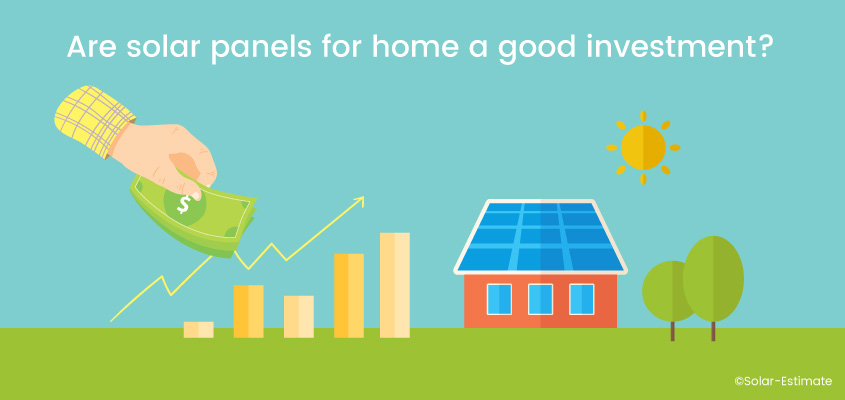Are solar panels for home a good investment?
Written by Zeeshan Hyder
Updated August 12, 2021
6 minutes read
Categories: Solar 101, Solar efficiency, Solar energy, Solar panels, Solar power

Going back a few years when solar was $5 a watt, it made little economic sense to install solar. Now, solar costs as little as $2.50 per watt before claiming any incentives; things are different.
The rapid decline in solar prices within the last 10 years has created the solar boom we know today. Incentives such as net metering, the federal solar tax credit, state solar tax credits and utility rebates have driven the price of solar to low prices unimaginable a few years ago.
Solar payback periods across America are now typically in the range of 6-8 years. With solar panels producing power for at least 25 years, this is pretty attractive. And given solar incentives are set to step down or expire soon, now is probably the right time to calculate your investment return on solar panels for home given your unique location, utility costs and roof availability.
What is net metering and how does it affect my return from installing a solar power system on my home?
Throughout the day solar panels will likely produce more energy than your home needs. This excess energy is sold to your utility through the grid, net metering requires your utility to compensate you at the retail power rate per kilowatt hour in the form of credit against your bill.
Net metering means you are billed or credited for your usage minus exported power from your solar system.
How do solar tax credits work?
Solar tax credits reduce your state/federal tax liability by a specified percentage of your total solar system cost. For example a $20,000 solar system with the 26% federal solar tax credit would result in a total system cost of $14,800, this means you would owe the IRS $5,200 less income tax.
Some states also offer solar tax credits which reduce your state income tax liability such as Massachusetts and New York.
How many solar panels do I need for my home?
The amount of solar panels you need will depend on your power usage. Most people that buy a solar energy system opt for an amount of solar panels that will generate a similar amount of power as what their home sues over a year. Where there is net metering this will mean suchy a system would come very close to leaving the house with a zero power bill (excluding fixed service fees).
Where can I find the solar installers near me?
Our sister site SolarReviews is the largest reviews site for solar panels and reviews of residential solar panel installation companies in America. This site has thousands of reviews for installers all across America for solar panels, solar inverters, solar batteries and solar installation companies.
The reviews allow you to make an educated decision on two of the three most important things that you are looking for when buying solar panels for your home: the quality of the equipment and the quality of the installation crew that will install it.
By entering your zip code below you will see the costs and savings from installing solar in your area and if you like elect to be contacted by a local solar installer.
Are solar roof shingles a good option to power my home?
Solar roof shingles have gained increasing attention because of their potential to offer better aesthetics than solar panels. The most significant recent solar shingles product release is the new Tesla solar roof tiles. The Tesla solar roof tiles have been launched with a lifetime warranty and both greater performance and superior aesthetics compared to previous offering from other BIPV solar manufacturers.
However, the downside is the Tesla solar roof cost. They can be upwards of 2-3 times the price of solar panels, making the cost $45,000-$55,000 for a typical home.
A solar roof shingle system in southern California, assuming a 1,800sq ft home size will save an average of $88,000 over 25 years in avoided utility bills. This means the average payback time for your investment would be about 15 years.
Most solar systems in southern California using conventional panels pay for themselves within 6-7 years, making the Tesla a poor deal by comparison.
Calculating solar panel cost for your home, how much solar will save you and your payback
The very first step, as we have indicated above, is to work out whether or not solar is likely to be a good investment. This depends on your local power prices, the amount of power you use and the solar panel cost charged by local solar companies.
Entering your location and the dollar amount of your most recent monthly power bill into our solar energy cost and production calculator will tell you your likely investment return and payback period. From this you can make a decision.
The same calculator can also get you binding solar quotes for your home if you choose to confirm your details and request them at the end of the calculator.
